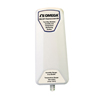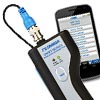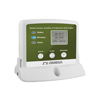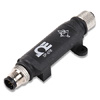As a maintenance engineer or plant operator, you have a critical responsibility to maximize uptime of the hundreds of pieces of equipment in your facility. You’re only too aware that a single breakdown can bring production to an abrupt and expensive halt. Every day, you face repairs and maintenance that need to be done. You’ve standardized parts, because uniformity and consistency mean you move faster with a smaller stockpile of spares. You switch equipment only if a machine fails repeatedly or your parts supplier can’t deliver on time.
But, you face a dilemma. Your run-to-failure strategy, known as reactive maintenance, costs you less in the present, because you’re not investing in plant maintenance. However, you’ll eventually spend far more in money and resources than necessary. In fact, the Marshall Institute reports that you’ll pay 2-5 times as much as you would have if you’d performed proactive maintenance. To add value to your facility, you must think beyond reactive maintenance. A choice for proactive maintenance can make a significant impact on your company’s profit and loss (P&L).
But, you face a dilemma. Your run-to-failure strategy, known as reactive maintenance, costs you less in the present, because you’re not investing in plant maintenance. However, you’ll eventually spend far more in money and resources than necessary. In fact, the Marshall Institute reports that you’ll pay 2-5 times as much as you would have if you’d performed proactive maintenance. To add value to your facility, you must think beyond reactive maintenance. A choice for proactive maintenance can make a significant impact on your company’s profit and loss (P&L).
What Is Reactive Maintenance?
Reactive maintenance focuses on restoring equipment to normal operation after a breakdown. To do that, you replace or repair faulty parts and components. When does reactive maintenance make sense? Let’s look at a simple example from your home: Changing a lightbulb. If parts are inexpensive and simple to replace—and failure doesn’t affect any high-value assets—reactive maintenance makes sense. The rule of thumb for plants is that less than 20 percent of maintenance should be devoted to reactive maintenance.
But unplanned repairs in a plant are usually far more complicated than changing a lightbulb. If you’ve invested little up to that point to maintain equipment, a breakdown means you’re faced with downtime, lost production, and safety and environmental risks that are greater during equipment startup and shutdown. You also pay more for complex repairs, spare parts not on hand, rush shipping to receive the parts, overtime for workers performing the repair, and missed deadlines on customer orders. The costs mount rapidly, dwarfing what you would have spent on proactive maintenance.
But unplanned repairs in a plant are usually far more complicated than changing a lightbulb. If you’ve invested little up to that point to maintain equipment, a breakdown means you’re faced with downtime, lost production, and safety and environmental risks that are greater during equipment startup and shutdown. You also pay more for complex repairs, spare parts not on hand, rush shipping to receive the parts, overtime for workers performing the repair, and missed deadlines on customer orders. The costs mount rapidly, dwarfing what you would have spent on proactive maintenance.
What Is Proactive Maintenance?
Proactive maintenance focuses on anticipating and managing machine failures before they occur. Proactive maintenance requires determining root causes of failure that you can eliminate, identifying potential failure locations, and avoiding breakdowns caused by deteriorating equipment conditions. After you identify critical locations, you can leverage hand tools for vibrational or temperature analysis on a regular basis to help determine the optimal maintenance strategy.
For example, if you discover a part needs periodic servicing or replacement, then preventive maintenance at set intervals may be appropriate. Preventive maintenance helps bring an asset back to like-new condition and eliminate any issues. You schedule the maintenance in advance, tell staff members which tasks to complete, and track parts, costs, and time required. Unfortunately, preventive maintenance is also invasive, meaning you’ll experience downtime while it’s being carried out. And you may lose some of the usable life in equipment if you perform maintenance before it’s necessary.
On the other hand, if you discover that machine breakdowns are sporadic, then predictive maintenance may be a better option for making sure critical equipment gets attention when needed. With the right sensors and a basic setup, you can collect data to help you predict impending equipment failure. You also know when to schedule preventive maintenance, so you don’t waste a minute of the usable life of any component. Unlike preventive maintenance, predictive maintenance is non-invasive, meaning machinery can keep operating while you determine its condition via direct monitoring and analysis. And the impact on P&L from predictive maintenance can be huge: McKinsey Global Institute estimates a 10 to 40 percent reduction in costs, up to 50 percent reduction in downtime, and 3 to 5 percent lower equipment and capital investment by extending machine life.
With a solid plan for proactive maintenance in place, you’ll get back every penny you invest and more. By investigating and resolving potential failures before they occur and being able to decide when preventive or predictive maintenance makes sense, you’ll extend the uptime and life of your assets and minimize the need for major repairs. Your assets will work harder for you, boosting their contribution to earnings, without downtime and unexpected failures.
With a solid plan for proactive maintenance in place, you’ll get back every penny you invest and more. By investigating and resolving potential failures before they occur and being able to decide when preventive or predictive maintenance makes sense, you’ll extend the uptime and life of your assets and minimize the need for major repairs. Your assets will work harder for you, boosting their contribution to earnings, without downtime and unexpected failures.
To learn more about getting started with predictive maintenance and first steps for outfitting your plant, check out this article on the benefits of predictive maintenance.
For example, if you discover a part needs periodic servicing or replacement, then preventive maintenance at set intervals may be appropriate. Preventive maintenance helps bring an asset back to like-new condition and eliminate any issues. You schedule the maintenance in advance, tell staff members which tasks to complete, and track parts, costs, and time required. Unfortunately, preventive maintenance is also invasive, meaning you’ll experience downtime while it’s being carried out. And you may lose some of the usable life in equipment if you perform maintenance before it’s necessary.
On the other hand, if you discover that machine breakdowns are sporadic, then predictive maintenance may be a better option for making sure critical equipment gets attention when needed. With the right sensors and a basic setup, you can collect data to help you predict impending equipment failure. You also know when to schedule preventive maintenance, so you don’t waste a minute of the usable life of any component. Unlike preventive maintenance, predictive maintenance is non-invasive, meaning machinery can keep operating while you determine its condition via direct monitoring and analysis. And the impact on P&L from predictive maintenance can be huge: McKinsey Global Institute estimates a 10 to 40 percent reduction in costs, up to 50 percent reduction in downtime, and 3 to 5 percent lower equipment and capital investment by extending machine life.
Proactive Maintenance Plan
With a solid plan for proactive maintenance in place, you’ll get back every penny you invest and more. By investigating and resolving potential failures before they occur and being able to decide when preventive or predictive maintenance makes sense, you’ll extend the uptime and life of your assets and minimize the need for major repairs. Your assets will work harder for you, boosting their contribution to earnings, without downtime and unexpected failures.
To learn more about getting started with predictive maintenance and first steps for outfitting your plant, check out this article on the benefits of predictive maintenance.









